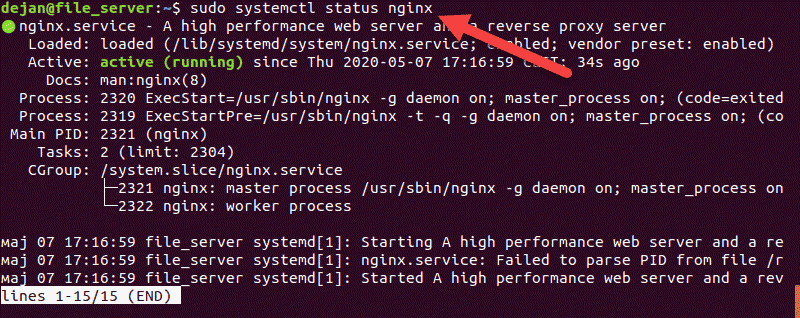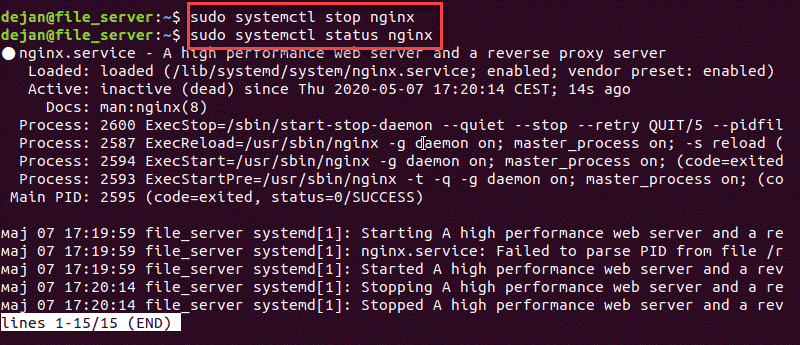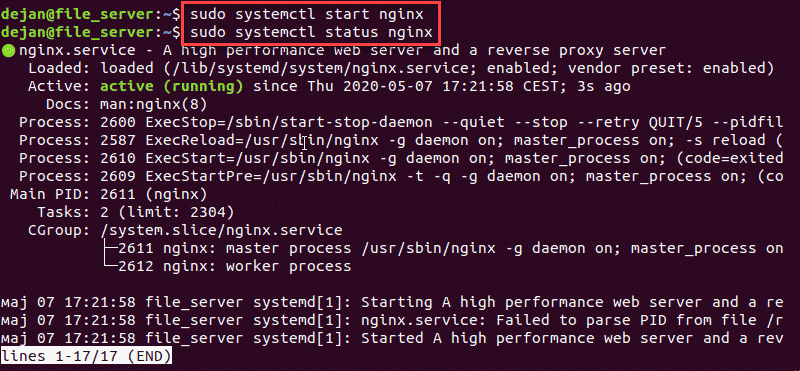Failed to Start Startup Script for Nginx Service
Failed to Start Startup Script for Nginx Service
Introduction
Nginx is a powerful server application that routes network traffic. It'due south often used as a reverse proxy server, but tin besides be configured every bit a regular web server.
One of the almost mutual operations you volition see is starting, stopping, and restarting the Nginx web server.
In this tutorial, learn how to start, cease, and restart the Nginx service.

Prerequisites
- A system with Nginx installed and configured
- Access to a final window or control line
- A user account withsudo orroot privileges
- An existing SSH connection to a remote organisation (if yous're working remotely)
Start, Stop, and Restart Nginx with systemctl
How to View Status of Your Nginx Server
Nginx runs equally a service on your server. That means that it should be actively running in the groundwork, fifty-fifty if you don't see anything on the screen. Y'all can brandish the status of the Nginx service by entering the following command in a final window:
sudo systemctl status nginx The system will switch into a condition mode, displaying lots of information virtually the Nginx service.
- If the service is running (agile), y'all'll run across a green active (running) condition in the third line.
- If Nginx is not running, it will display asinactive in standard white.
- If something went wrong and Nginx couldn't load, you'll encounter a red statusfailed, with some information about the failure.

Press q to reactivate the fustigate prompt.
SystemD is the default service director on modern versions of Linux distributions (Ubuntu xx.04/18.04/16.04, CentOS seven/7, and Debian 9/10 ). The SystemD director functions through the systemctl command.
The systemctl control is a base Linux control. That means that it can exist used for any Linux service.
Stop and Offset Nginx
systemctl can be used to get-go and stop the Nginx service.
To terminate Nginx, run the following command:
sudo systemctl end nginx 
To first Nginx, execute the systemctl command with the first choice:
sudo systemctl start nginx 
How to Restart Nginx
Gracefully Restart Nginx
If yous're refreshing Nginx after irresolute the configuration, it's all-time to gracefully reload the service. That shuts downward erstwhile processes and restarts new ones with the new configuration.
Employ the systemctl Linux control to reload the Nginx service. Run the following command:
sudo systemctl reload nginx Annotation: Nginx cannot exist reloaded if the the Nginx service is not active.
Force Restart Nginx
For major configuration changes, you can force a full restart of Nginx. This strength-closes the whole service and sub-processes, and restarts the whole package.
Enter the following control:
sudo systemctl restart nginx Restart vs Reload Nginx
The reload control keeps the Nginx server running every bit it reloads updated configuration files. If Nginx notices a syntax error in any of the configuration files, the reload is aborted and the server keeps running based on old config files. Reloading is safer than restarting Nginx.
The restart command volition shut down the server including all related services and power it on over again. Restart Nginx only when making significant configuration updates, such as changing ports or interfaces. This control will strength shut down all worker processes.
Configure Nginx to Launch on Boot
Use the enable choice with the systemctl control to enable Nginx:
sudo systemctl enable nginx Use the disable choice with the systemctl command to disable Nginx:
sudo systemctl disable nginx Start, End, and Reload Nginx with the Nginx Control
Nginx has a set of congenital-in tools for managing the service that tin exist accessed using the Nginx command.
Nginx Start
To start Nginx and related processes, enter the following:
sudo /etc/init.d/nginx start If run successfully, the terminal output will display the following:
Output [ ok ] Starting nginx (via systemctl): nginx.service. Nginx Restart
To force close and restart Nginx and related processes:
sudo /etc/init.d/nginx restart 
As an culling, use the nginx -s command:
sudo nginx -south restart Nginx Cease
To disable or finish the Nginx service, enter the following:
sudo /etc/init.d/nginx cease 
Alternatively, use:
sudo nginx -south stop Nginx Reload
To gracefully finish and restart Nginx and related processes, employ the command:
sudo /etc/init.d/nginx reload 
Alternately, you can employ the nginx -south command to pass instructions directly to Nginx:
sudo nginx -s reload Nginx Quit
Force close the Nginx service by using the quit educational activity with the nginx -s command:
sudo nginx -south quit Determination
This article has outlined several methods to showtime, stop, and restart Nginx on your server. Use these commands for the most common operations when managing an Nginx web server.
Was this commodity helpful?
Yes No
Failed to Start Startup Script for Nginx Service
Posted by: dunkinfousee1994.blogspot.com